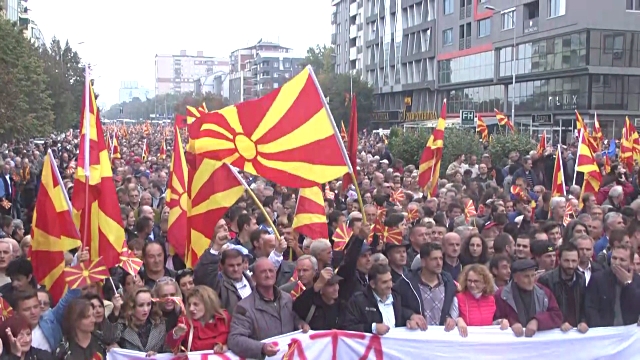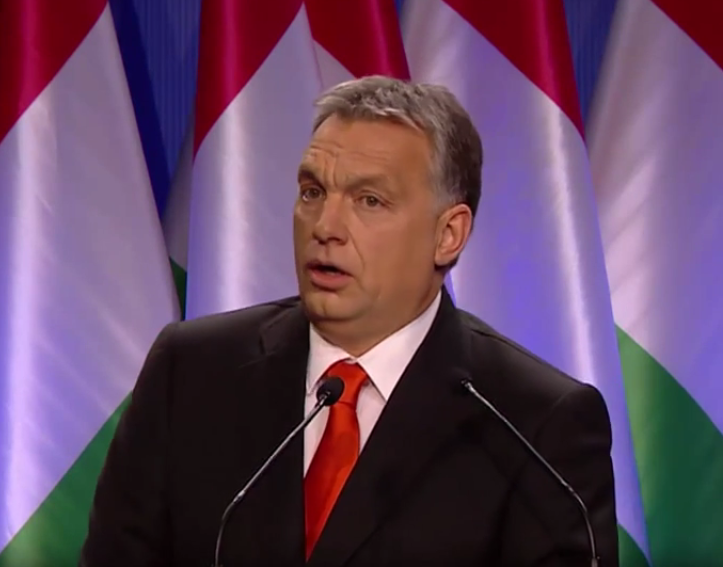By Modeste Schwartz.
Central Europe – For more than a month, the currencies of Central Europe (a term that, for my part, I always use in a conventional/geographical sense: post-communist Europe outside the former USSR) have dropped against Western currencies – be it the dollar, the euro or the pound sterling: this devaluation of 5% to 10%, in a context of stable transaction volumes, affects practically all countries in the region (with the exception, of course, of Slovakia, which made the choice of the euro in 2005).
Two obvious conclusions follow from this simple observation:
1) Despite the desperate efforts of a largely discredited liberal press seeking, notably in Hungary and Romania, to interpret this development as the manifestation of a foreseeable failure of the more or less “heterodox” economic policies pursued by the governments of these countries (for 8 years in Hungary and for 4 years in Romania), this lie falls flat if we consider the geographical extent and chronology of the phenomenon, affecting as well the rich and industrious Poland (see euro/zloty) as a still predominantly extractive Romania (see dollar/leu), and affecting as well this same Romania, still largely subjected to Western dictates, as it affects the “rebellious” Hungary (see dollar/forint).
2) Conversely, even though it would never occur to me to deny the reality of politically motivated currency-manipulation, the “conspiracy theories” which would like to see it as a “punishment of central Europe” (for example, for its massive rejection of the “Open Society”’s migration policies) hardly deal with the reality of the phenomenon, both in its timing (it has worsened after the Hungarian elections, and while the Romanian presidential elections are still – in principle – relatively far from us) and in its extent (why, for example, punishing Romania, which remains a paradise of Western subcontracting with “negotiated” taxation, has kept a low profile during the “migration crisis” and subsidizes the Western military-industrial complex well beyond its reasonable means, given its anemic budget capacity?).
In short, it is clear that this is a real and deep financial trend (not a smoke screen serving a political agenda), and one that requires a global explanation.
Such an explanation was provided by the Hungarian Prime Minister Viktor Orbán himself, in a rather plain manner, during a radio interview on June 8, also uploaded to YouTube under the title “It is possible that the crisis happens”. Asked by a journalist why, in the draft budget of 2019, the reduction of the Hungarian budget deficit goes beyond the requirements of Brussels in this area, he replied that his government wants this budget to be a ‘secured growth’ budget, which must be ‘earthquake proof’. Asserting “to listen to the advice of leading Hungarian economists”, he considers as likely a global recovery in interest rates, as well as the aggravation of a global “trade war” already underway (which, by aggravating instability of the globalized economy, can only strengthen the upward trend in interest rates).
In doing so, we can hardly say that Viktor Orbán has betrayed a real secret anymore. Long anticipated by various analysts, a remake of the crisis of 2008 (whose inevitability derives from very serious reasons – for example, those exposed for months by the French author Michel Drac) could well occur before the end of the year, or in 2019 at the latest. Its imminence – for easily understandable psychological reasons – is rarely the headline story, but it becomes increasingly easy to discern it in the background of various statements – including statements made by government party officials of the Western EU. Reacting to the Macron-Merkel Meseberg statement (which includes a cautious call for the creation of a common European budget), Wolfgang Steiger, secretary-general of the Economic Council of the CDU, criticizes the position of his own chancellor, stating in particular that “Europe needs a clear mechanism so that eurozone countries can restructure their debts in the event of a crisis.”. Of course, the conscious goals of such a declaration, and of its dissemination (by the Wirtschafswoche, retaken by Euractiv) have mostly to do with German inner politics (in the run-up to the Bavarian elections): Steiger – who might also be speaking under the influence of German banking interests – probably fears, at a political level, a divorce between his party and the CSU (the latter might probably indeed be able of sawing, by ordo-liberal fanaticism, the Brussels branch on which German prosperity sits – history will shortly tell). The imminence of the crisis is, in this discourse, simply a context element, not the topic under focus, and apparently already represents an obviousness in the discussions held off-the-record by said Steiger and the European decision-makers of the same level. Similarly, the above-mentioned interview of Viktor Orbán, given in Hungarian on Hungarian national radio, is primarily aimed at the Hungarian public, and not at the financial markets (who do not really need him to know what to do). It is all the more interesting to note from these two politicians that everything else separates (apart from their common membership, more and more nominal, in the EPP), the existence of the same horizon of expectation in economic and financial matters.
And this is not new: one can wonder to what extent the recent Catalan crisis – beyond the historically complicated Madrid-Barcelona relations – was not largely inspired by the fears of a Catalan bourgeoisie who would like to be in a position to negotiate the size of the pound of flesh she will have to deliver during the financial slaughtering of Spain (the coming of which can only be accelerated in the case of global crisis). Finally, by pushing daring speculation a little further, it is also not forbidden to think that the support granted by certain sectors of Anglo-Saxon capitalism to Brexit and Donald Trump’s campaign could also have resulted from a desire to best position themselves on the bridge of the global financial Titanic, just in time before it impacts the iceberg.
Once this hypothesis is accepted, the recent crisis in Central European currencies is no longer mysterious at all. Those who, like me, had the dubious privilege of being old and finance-savvy enough to understand the chain of events during the “Crisis of 2008” remember that a fall in the prices of these same currencies had also been part of the warning signs of this crisis, and for reasons well known (but which the mainstream press is careful not to recall): in various proportions (a little less in Poland, a little more in Hungary, and totally in Romania), the banking systems of these countries remains largely dominated by Western banks, present either through subsidiaries with the same name (Société Générale, Erste Bank, Raiffeisen, etc.), or hardly concealed under banks formerly founded by local capital, but which they have taken over in the meantime. However, any anticipation of raising global interest rates leads (one is almost ashamed to have to recall this) to a (at least potential – anticipatory) credit crisis, which aggravates the already enormous exposure of Western banks (due, in particular, to minefields of “derivatives” that dot their balance sheets) at the risk of sudden monetary retraction; the mother banks are therefore striving to strengthen their internal capitalization, in particular by decapitalizing their subsidiaries in the peripheral countries, which are obliged to absorb the shock, given that they stand on the wrong side of this “limited monetary sovereignty” whose global watchdogs are the ECB, the IMF, the World Bank, etc.. They thus create a famine of Western currencies on the local markets, which, by the law (globally distorted, but locally effective) of supply and demand, causes these currencies to rise in relation to local currencies (for whom the only way to escape the trap would be a de-dollarization/de-euroization of local banking systems – naturally impossible in the absence of a banking system with indigenous capital).
Regarding the foreseeable consequences of the phenomenon, let us start by removing some of the false conclusions that could be dictated by a superficial or biased analysis: no, in the short term, these devaluations are not catastrophic for Central Europe. They boost its exports (including the in situ export called ‘tourism’, very important in the Hungarian economy), make wage gains to the multinationals present on the spot (who pay their workers in lei, forints, zlotys, etc., but sell their products in euros or dollars after final assembly in Germany, Austria, France, etc.), and therefore encourage investment (for example the boom of IT in Romania, which does not disarm, despite the paper scarecrows waved by the local pro-Western press as part of its anti-PSD campaigns). Moreover, they encourage the much-needed regional economic integration – since all these currencies remain relatively stable relative to each other, falling only against Western currencies, and more or less at the same pace; in the long run these devaluations could, mutatis mutandis, have the same – ultimately salutary – consequences as the sanctions imposed on Russia since the Ukrainian crisis: reduce imports (especially food), and push to produce locally for local and regional markets. One could argue that they also encourage the export of brains, which is technically true, but not very significant, given that the brain drain has already reached structural limits (manifested by the disappearance of unemployment and by permanent wage growth in the region for more than a year).
In the medium and long term, on the other hand – that is to say: concerning the consequences to be expected after the onset of the crisis which is looming on the horizon – the picture is less rosy. Hungary and Poland, in particular, are highly urbanized and relatively well industrialized, but owe it to a reindustrialization process tragically dependent on German capital; they export fairly well, but also import a lot, and mainly from the euro zone. This makes us understand better the medium-term stakes of Viktor Orbán’s policy of Eastern Opening (notably to the Silk Road): if Germany were to lose the ongoing financial and commercial war, the big German groups could, under political pressure, try to save their German settlements by repatriating part of the production so far de-localized in its central European hinterland – in which case countries like Hungary and Poland would have to choose between a galloping budget deficit (because of the collapse of their trade balance) and a reorientation (actually already happening) of their imports of goods and capital – which, eventually, will inevitably also pose the problem of their geopolitical loyalty – whose sole real guarantor, at the moment, seems to be the obsession with a Russian threat, which possesses (for understandable reasons) the Baltic states, as well as, at various degrees (and for more questionable reasons) Poland and Romania.
As for Romania, because of its lower industrialization and the ‘externalization’ of a quarter of its population, it is both less exposed to the long-term consequences described above (since many Romanian people earn all or part of their wage … in Western currencies), and more sensitive to the short-term consequences, being both a net importer vis-à-vis the euro zone and benefiting, in proportion, much less from the EU’s largesse (which “Brussels” naturally prefers to direct towards Budapest and Warsaw, where it actually finances … the German industry): this configuration makes the risk of inflation (frenetically brandished for months by the anti-PSD press) more and more credible (although not for the reasons usually put forward by that press), and the ruling coalition in Bucharest, in order to be able to capitalize positively on the consequences of an inflationary context, will first have to give a concrete expression to its ambitions as an economically interventionist state (and in particular to create this sovereign fund which, as a Loch Ness monster, reappears every six months on the surface of the PSD discourse, but without ever producing a firm timetable). More generally, even though the last 15 to 18 months have demonstrated the stability of the PSD-ALDE regime, despite all hysterical protests staged by “civil society”, in a context of growth (particularly high in Romania), one may wonder to what extent its current style of government – relatively passive, managerial, timorous and apolitical – will withstand a regional, or even European or global, growth-draught.




